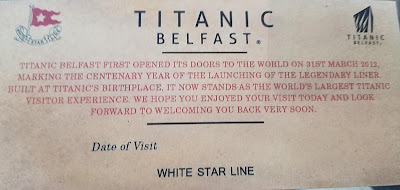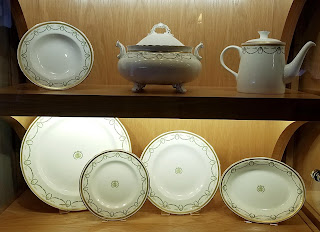We had a city orientation of the highlights of Belfast including City Hall, Queen's University, the Albert clock tower more. The Albert Memorial Clock is a clock tower situated at Queen's Square in Belfast, Northern Ireland. It was completed in 1869 and is one of the best known landmarks of Belfast.

Queen's University Belfast is a public research university in Belfast, Northern Ireland. The university was chartered in 1845, and opened in 1849 as "Queen's College, Belfast". Belfast is different than Dublin, smaller, newer, more industrial, definitely more British than Irish.
Then we headed to the Titanic Museum, a fascinating exhibit housed in the very docklands where this most famous ship was built and launched before her tragic maiden voyage.
We spent 2 hours here, and it was fantastic! The exhibits described Victorian era, post famine Belfast with its shipbuilding, linen works, tobacco, whiskey and rope industries. Harland and Wolff ship builders took up 80 acres and employed 10,000 workers when they received the contract to build the ill fated ship. It was launched from here:
Model of the ship yard during the building process of Titanic
The ground floor of the museum took visitors through the entire building process, from welders to rivets, framers and plating. An elevator up to the 4th floor lead to a cool 5 minute ride that took you through the process, with voices and images describing daily life and vivid sounds of the workers building the ship.
Prior to the launch, it took 3 thousand men 10 months to outfit the interior once built. We saw swatches of the original carpets and fabrics used, china service, menus as well as 1st, 2nd and 3rd class state room reproductions. There was even the actual suit that Barbara Stanwick wore in the 1953 Titanic movie.
2nd and 3rd class cabins
1st class stateroom below
We stepped into a virtual tour, 3 sided, that surrounded and took us through each level of the ship. It was amazing and just like being inside... from the boiler rooms, to state rooms, decks, dining rooms and lounges, all the way to the top deck where the Captain steered the ship.
Boiler room
3rd class dining room
1st class salon and dining
Then, it detailed the frantic messages wired from the Captain as the iceberg was hit, followed by vivid recreations of the sinking. There were audible descriptions of the chaos, suffering and death, told in survivor voices, as well as actual lists of bodies recovered and their identifying possessions etc. Many were buried in Halifax Nova Scotia and many were never found.
Finally, there was a movie showing the debris field and wreckage on the ocean floor today at 12,400 feet below. SO many objects still remain where they landed over 100 years ago, from tin cups to china, bathtubs, chandeliers and more.
I can't say enough about how awesome this museum was... so well done. The building itself, which resembles a ship, sits on the dock land next to the spillway where the ship was launched. The view of Belfast across the river is great!
We had a few hours at leisure, and I opted to take a Black Taxi tour of the political murals, gates and Peace Walls which divide the Catholic Republican from the Protestant Loyalist communities. I really need an Irish History for Dummies book. I'm still a little confused. Walter lead our tour and has been driving a black taxi since 1995 when bus bombings were so frequent they needed alternate transportation.
Neighborhoods on both sides of the peace wall, Catholic and Protestant, are poor, filled with government housing. He showed us turn of the century low income "homes" that had no bathrooms until the government added them in the 1980s. Now they have tiny additions at the back.
There are cameras everywhere and a watch tower. Barbed wire stretches along the top of the 3 mile wall. The peace process is slow but no bombs have gone off and no one tosses bottles over the wall any more. In 2007, the British Army left for good. The walls were supposed to be there for 6 months but have remained for 40 years, with people coming and going somewhat freely. It is a fragile situation for sure.
Sometimes the conflict is painted as a sectarian argument – between Protestants and Catholics – but it’s really all about politics. It’s about whether Northern Ireland should be a part of the United Kingdom or a part of the Republic of Ireland. A peace may have been eventually negotiated but it’s even harder to change political views. That can take generations – if it’s even possible. And so the walls remain. There are at least 40 of them through Belfast, separating suburbs that are predominately unionist and nationalist. If added up together, they run for almost 20 miles and there are many gates. Our green Irish Paddywagon tour bus would not have been welcome on the Protestant side, so that's why Black Taxi tours exist. The neighborhoods have no problem with those.
The worst year of violence was 1972 with 470 deaths and 1300 bombs. The Catholic IRA, backed by the Sinn Fein party fought the Protestant Ulster Volunteer Force (UVF). Murals on the Catholic side honor Castro, Palestine, Nelson Mandella and others who were involved with revolution or civil rights activities. Not sure why the ruthless dictator Castro is revered but he is. The Irish Catholic hero/revolutionary martyr is Bobby Sands shown here. Robert Gerard Sands was a member of the Provisional Irish Republican Army who died on hunger strike while imprisoned at HM Prison Maze after being sentenced for firearms possession. He was the leader of the 1981 hunger strike in which Irish republican prisoners protested against the removal of Special Category Status.
The Protestants honor King William III of Orange and the Orange Order. It is headed by the Grand Orange Lodge of Ireland, which was established in 1798. Its name is a tribute to the Dutch-born Protestant king William of Orange, who defeated the army of Catholic king James II in the Williamite–Jacobite War (1688–1691). Its members wear orange sashes and are referred to as Orangemen, and they parade and celebrate on July 12th every year. Their murals (below) honor the victims of IRA violence, and they also support Israel. Interesting...
The wall viewed from the Protestant side
AT the end of the tour, we had the opportunity to sign the peace wall. Our guide Walter said some Americans had recently referenced and encouraged Trump's southern border wall in their messages, so I followed suit, He gave us black markers which were a little hard to write with ;)
After Walter's informative tour, I happened upon and joined a guided tour of City Hall, a beautiful building where the Council and Lord Mayor convene. The Lord Mayor of Belfast is the leader and chairperson of Belfast City Council, elected annually from and by the City's 60 councillors. The Lord Mayor is Deirdre Hargey of Sinn Féin, while the Deputy Lord Mayor is Emmet McDonough-Brown of the Alliance Party of Northern Ireland, both elected in June 2018.
In 1888 Queen Victoria granted Belfast the status of the city and it was agreed that a grand and magnificent building was required to reflect this new status. City Hall opened its doors on the first of August 1906, at a time of unprecedented prosperity and industrial might for the city. The new City Hall was designed by Alfred Brumwell Thomas in the Baroque Revival style and constructed in Portland stone. The incredible building cost £369,000 to complete, the equivalent around 128 million pounds today but remains an extraordinary beacon of success and civic pride for Belfast.
Council chambers
Gorgeous dome and chandelier
Lord Mayor's jewels
Lord Mayor's gilded robe
After that, our tour bus left Belfast at 2:30, and Sean dropped me at the Dublin airport where I caught the Hilton shuttle back to my hotel for the night. My flight to JFK leaves in the a.m. at 11:30, then to Vero Beach for a week or so before heading home to DC. What a great trip this has been...












































No comments:
Post a Comment